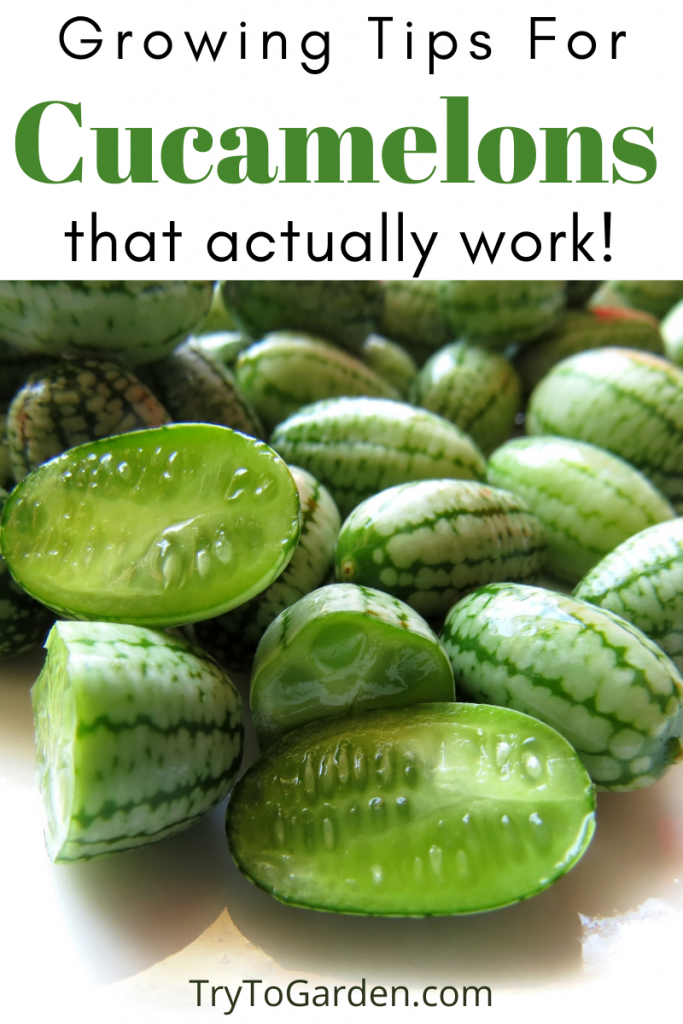This post contains affiliate links, which means I will make a commission at no extra cost to you should you click through and make a purchase. As an Amazon Associate I earn from qualifying purchases.
A cucamelon is a tiny, tasty cross between a cucumber, watermelon and lime. They are easy to grow and delicous to eat. Here are the top tips and things you need to know about growing cucamelons!

Jump to:
- Why Grow Cucamelons
- Gardening Tips That Really Work
- History of the Cucamelon
- Benefits of Cucamelons
- Basic Cucamelon Facts
- Best Soil For Growing Cucamelons
- How To Plant
- Caring For Cucamelon Plants
- Harvesting Cucamelons
- Enjoying Cucamelons
- Easy Cucamelon Recipe
- Like Gardening Tips for Cucamelons? Try these growing tips:
If you're interested in growing cucamelons, this blog post will provide some helpful tips for success. Gardening can be hard at times, but with the following tips it's easy to get started on your own cucamelon garden today!
Why Grow Cucamelons
Cucamelons are a fun, resilient and interesting plant to grow. They produce these amazing fruit that looks like mini watermelons on the outside, cucumbers on the inside but are sweet and tart, reminiscent of limes.
Gardening Tips That Really Work
Cucamelons are easy to grow in a home garden. They're resistant to pests and tolerant of low humidity, which can be really helpful for those who live in dryer climates (or just want an easier time with watering).
History of the Cucamelon
The cucamelon is a hybrid of the West Indian gherkin and Mexican Sour Cucumber, which was discovered in 1976 by horticulturalist Tom Wagner at his family farm in Southern California.
Cucamelons are native to Mexico and Central America, where they’re known as sandita or “little watermelon.” They’re also called mouse melons or Mexican sour gherkins. Though they seem like a cross between a watermelon and a cucumber, they’re not actually a version of either plant but their own species entirely.
Benefits of Cucamelons
Being a blend of both watermelon and cucumbers, it should come as no surprise to you! Cucamelons have numerous health benefits! They are rich in Lycopene, beta carotene, minerals, vitamins K, E, C, and fiber. That means they have a heart-improving antioxidant, help to maintain eye health, and maintain younger-looking skin.
Cucamelons are small but pack a healthful punch. They are full of vitamins and minerals, antioxidants and fiber, and are also low in calories. The nutrients they provide can help lower the risk of heart disease, stroke, and cancer.
Basic Cucamelon Facts
They take about 7 to 14 days to germinate, depending on temperature.
While cucamelons grow best in areas with hot, relatively dry summers, they're adaptable.
Cucumelons are a warm-season crop; they are harmed or killed by frost and grow and produce best at daytime temperatures of about 65° to about 75°F
This is a tough one to answer as it depends on the time of year you plant them, the water they get, and the temperatures.
Cucamelons taste very similar to a regular cucumber: mild, crisp, and refreshing. They also have a slightly sour taste similar to a lemon or lime. The fruits grow to a size similar to a grape or cherry tomato, which makes them a perfect addition to a fresh salad.
Best Soil For Growing Cucamelons
Nutrient rich soil is the key to growing success with these plants. Choose a garden with nutrient dense soil or amend the soil with aged manure or compost. Like cucumbers and tomatoes, cucamelons love heat. Pick a spot with full sun to get the best fruit harvest from your cucamelon crop.
How To Plant
Cucamelons are fairly fast growers, with plants reaching full maturity in about 80 days. This means they’re well-suited for cooler climates where the growing season isn’t as long.
Cucamelon plants are vigorous vines that are best grown up trellises, tunnels, or other supports. Seriously consider trellising the plants.
Caring For Cucamelon Plants
Cucamelon plants are fairly low maintenance and don’t require much special care as they grow. They do require a lot of water, so make sure you don’t miss out on regular watering sessions.
Harvesting Cucamelons
You’ll know cucamelons are ripe when they start to yellow and develop a waxy sheen. Fruit is ready to harvest when it reaches the size of a grape and is still firm. Leaving them on the plant longer can result in a slightly bitter flavor and a soggy texture. Pick cucamelon fruits before this occurs - as once they ripen, the seeds will have fully developed within the fruit's flesh.
Enjoying Cucamelons

With no hard rind to deal with, you can eat them straight from the vine. Cucamelons are best eaten raw or blended into a juice. They can also be used as an ingredient in various recipes - the possibilities are endless!
The cucamelon's thin skin doesn't need to be peeled before eating- just rinse them with water and enjoy! We like to eat them like grapes or slice them and add them to salads. They are even good pickled! I heard that some people are even using them to garnish cocktails...what fun with that pop of bright green color!
Easy Cucamelon Recipe
Any bread and butter pickle recipe should work well - and any salad recipe that calls for grapes? Switch them out! I make a curried chicken salad recipe and like to switch out the grapes for these little gems.
